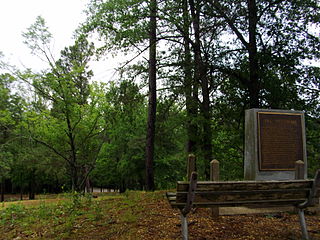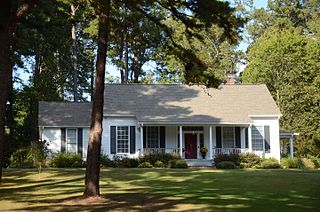
Camden is a city in and the county seat of Ouachita County in the south-central part of the U.S. state of Arkansas. The city is located about 100 miles south of Little Rock. Situated on bluffs overlooking the Ouachita River, the city developed because of the river. The recorded history began in 1782 when a Spanish military post was established on the site of an old French trading post called Écore à Fabri. When Ouachita County was formed in 1842, American settlers changed the name to Camden. The city became an important port during the steamboat era when Camden became known as the “Queen City” of the Ouachita. In 1864, Camden became the unintended focus of the Red River Campaign, a major Civil War effort resulting in several significant battles.

Historic Washington State Park is a 101-acre (41 ha) Arkansas state park in Hemsptead County, Arkansas in the United States. The museum village contains a collection of pioneer artifacts from the town of Washington, Arkansas, which is a former pioneer settlement along the Southwest Trail. Walking interpretive tours are available throughout the 54 buildings. Washington served as a major trading point along the Southwest Trail, evolving into the Hempstead county seat and later the capital of Arkansas from 1863 to 1865 when Little Rock was threatened during the Civil War. The original plat of Washington was added to the National Register of Historic Places in 1972 as the Washington Historic District.

Poison Springs Battleground State Park is an Arkansas state park located southeast of Bluff City. It commemorates the Battle of Poison Spring in the American Civil War, which was part of the 1864 Camden Expedition, an element of a Union Army initiative to gain control of Shreveport, Louisiana and get a foothold in Texas.
Elliott House or Elliot House may refer to:

The Camden Expedition Sites is a national historic landmark consisting of nine nationally significant historic places in southwest Arkansas where events of the Union army's disastrous Camden Expedition of 1864 occurred during the American Civil War. The Union was attempting to take over Shreveport, Louisiana. Each of the sites are individually listed on the National Register of Historic Places. It was designated a national historic landmark on April 19, 1994.

The Jenkins' Ferry Battleground State Park is the site of the American Civil War battle of Jenkins' Ferry, also known as the Engagement at Jenkins' Ferry, fought on Saturday, April 30, 1864, in present-day Grant County, Arkansas. The park was listed in the U.S. National Register of Historic Places on January 21, 1970, and, with seven other sites, is part of the Camden Expedition Sites National Historic Landmark, designated a National Historic Landmark District on April 19, 1994.

Marks' Mills Battleground State Park is an Arkansas State Park located at the junction of Arkansas Highway 8 and Arkansas Highway 97, north of New Edinburg, Arkansas. It preserves a portion of the battlefield of the Battle of Marks' Mills fought on April 25, 1864, in the Trans-Mississippi Theater of American Civil War. The battle was part of the Camden Expedition. The park is one of nine historic sites that make up the Camden Expedition Sites, a National Historic Landmark District. The battle was most know for the slaughter of black Union soldiers that were murdered as they try to surrender.

Fort Southerland, also known as Redoubt E and possibly Fort Diamond, is an earthen redoubt built in 1864 to protect Camden, Arkansas. Confederate forces built it along with four other redoubts in early 1864 after a Union victory in the Little Rock campaign the previous year. Fort Southerland is about the size of a city block and is roughly oval- or bowl-shaped. It emplaced three cannons. When Union forces captured Camden in April 1864 during the Camden Expedition, they improved the defenses of the five redoubts, which were not sufficient for proper defense of the city. After the Confederates retook Camden, they continued to improve the city's defenses.

The Confederate State Capitol building in Washington, Arkansas was the capital of the Confederate state government of Arkansas, during 1863–1865, after Little Rock, Arkansas fell to Union forces in the American Civil War. It is located within Historic Washington State Park, and is a National Historic Landmark.
Frenchport is an unincorporated community in Ouachita County, Arkansas, United States. Frenchport is located on local roads 8.4 miles (13.5 km) south-southeast of Camden. The Capt. John T. Burkett House, which is listed on the National Register of Historic Places, is located near Frenchport.

Harvey's Grocery and Texaco Station is a historic retail establishment at 3241 Arkansas Highway 24, between Camden and Chidester, Arkansas. The single-story concrete block building was built in 1940 by Henry Harvey, replacing a log structure that had previously housed his retail establishment. The building is one of the best-preserved examples of 1940s vernacular general stores and gas stations in the Camden area. The style of the building is, despite its modern construction materials, reminiscent of 19th century retail buildings, with a small windows placed high on the sides, and a full-width front porch. The Harveys pumped gas until 1979, after which the tanks were removed. Harvey's was also a locally notable stop for politicians on the stump in Arkansas: those who are known to have stopped here were Bill Clinton, David Pryor, and Jay Dickey.

The McCollum-Chidester House is a historic house at 926 Washington Street NW in Camden, Arkansas. It is now a museum operated by the Ouachita County Historical Society, along with the Leake-Ingham Building at the rear of the property. The 1+1⁄2-story wood-frame house was built in 1847 by Peter McCollum and sold ten years later to Colonel John T. Chidester. It is one of the finest pre-Civil War Greek Revival mansions in the state. Chidester was a prominent businessman who controversially sought to do business with Union interests during the Civil War. After the war he established a mail company that operated so-called "Star routes" as far west as the Arizona Territory. He was not implicated in bribery scandals that attended this operation.

Oakland Cemetery is a historic cemetery in Camden, Arkansas, located on Maul Road between Pearl Street and Madison Avenue. Established in 1830, it is the city's oldest cemetery. It consists of just over 7 acres (2.8 ha) of land donated in that year by William L. Bradley, one of Camden's founders. It is the burial site of many of Camden's leading citizens. Among them is James Thomas Elliott (1823–1875), a former Confederate soldier who represented Arkansas's 2nd District as a Republican.

The Richmond-Tufts House is a historic house in rural Ouachita County, Arkansas, outside the county seat of Camden. This single-story wood-frame house was built in 1853, and was originally located on West Washington Street in Camden, before being moved to its present location c. 1961. When first built, the house had Greek Revival styling, but it was extensively renovated and extended after its purchase in 1883 by Alfred Tufts, who moved from the northern United States to Camden after the American Civil War, married a local woman, and acquired a great deal of land. He made numerous Late Victorian additions to the house, most of which were undone when the house was moved, restoring its original Greek Revival character. The house is five bays wide, with a side gable roof, and a four-column porch that extends across a portion of the front.

The Sidney A. Umsted House is a historic house at 404 Washington Street in Camden, Arkansas. The two story brick house was built in 1923–24, and is one of the best local examples of Mediterranean Revival architecture in the city. Sidney Umsted, for whom the house was built, became instantly wealthy with the discovery in 1922 of oil in nearby Smackover, and became one of Arkansas' wealthiest men. The house is faced in beige brick, and features a green tile roof.

The Washington Street Historic District of Camden, Arkansas, encompasses an area that has been a fashionable residential area for much of the city's history. It includes six blocks of Washington Street, three of Graham Street, and three connecting streets. The oldest houses in this area are pre-Civil War Greek Revival houses, built in the 1840s and 1850s when Camden was at its height as a major regional center of the cotton trade. Another round of development took place late in the 19th century after the railroad arrived, resulting in a number of Queen Anne, Colonial Revival, and Classical Revival houses. The last major building spurt took place during southern Arkansas' oil boom in the 1920s and 1930s, when Mission/Spanish Revival, Mediterranean, and English Revival houses were built. The district included 68 contributing properties when it was first listed on the National Register of Historic Places in 2010. Six structures were previously listed separately on the National Register. The district was enlarged in 2018.

The Elliott House is a historic house at 309 Pine Street in Fordyce, Arkansas. The 1+1⁄2-story wood-frame house was built in 1925, and is a well-executed example of Craftsman style. It is a rectangular structure with three overlapping gabled roof sections with different pitches. The eaves are wide, and decorated with knee braces and exposed purlins. A fourth gable extends over the main entry, which has a twelve-light door with flanking sidelight windows.

The Elliott and Anna Barham House is a historic residence in Zinc, Arkansas. It is listed on the National Register of Historic Places. It was the home of Elliott Barham, son of the founder of Zinc, Arkansas, and his wife, Anna Barham.

The 2020 United States House of Representatives elections in Arkansas was held on November 3, 2020, to elect the four U.S. representatives from the state of Arkansas, one from each of the state's four congressional districts. The elections coincided with the 2020 U.S. presidential election, as well as other elections to the House of Representatives, elections to the United States Senate, and various state and local elections.

















